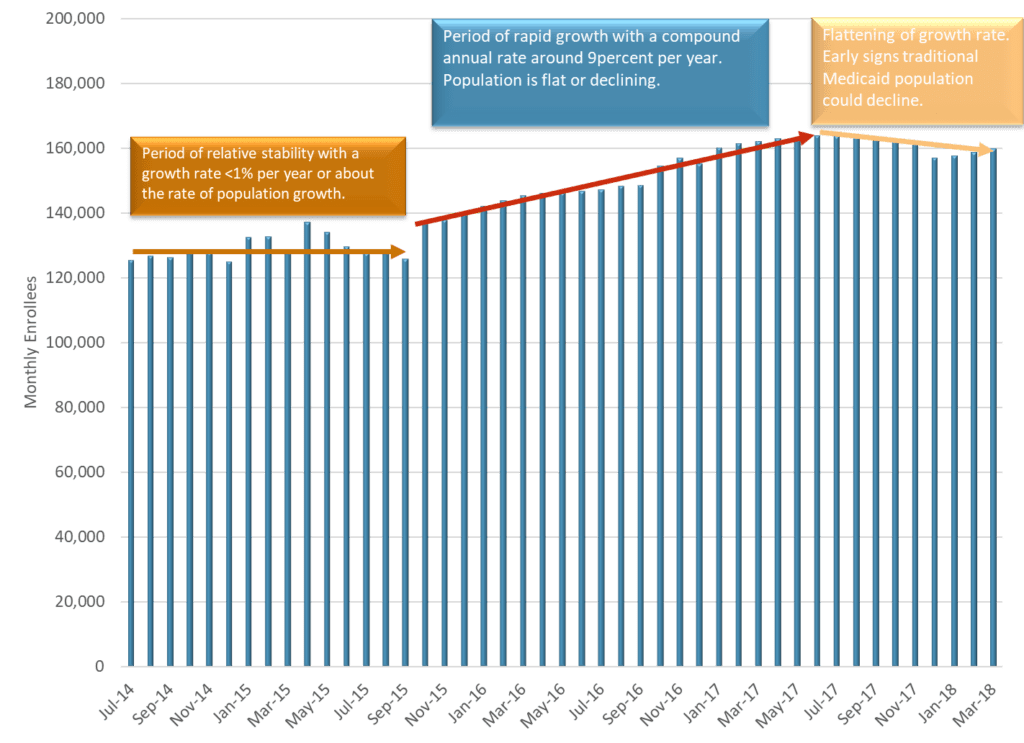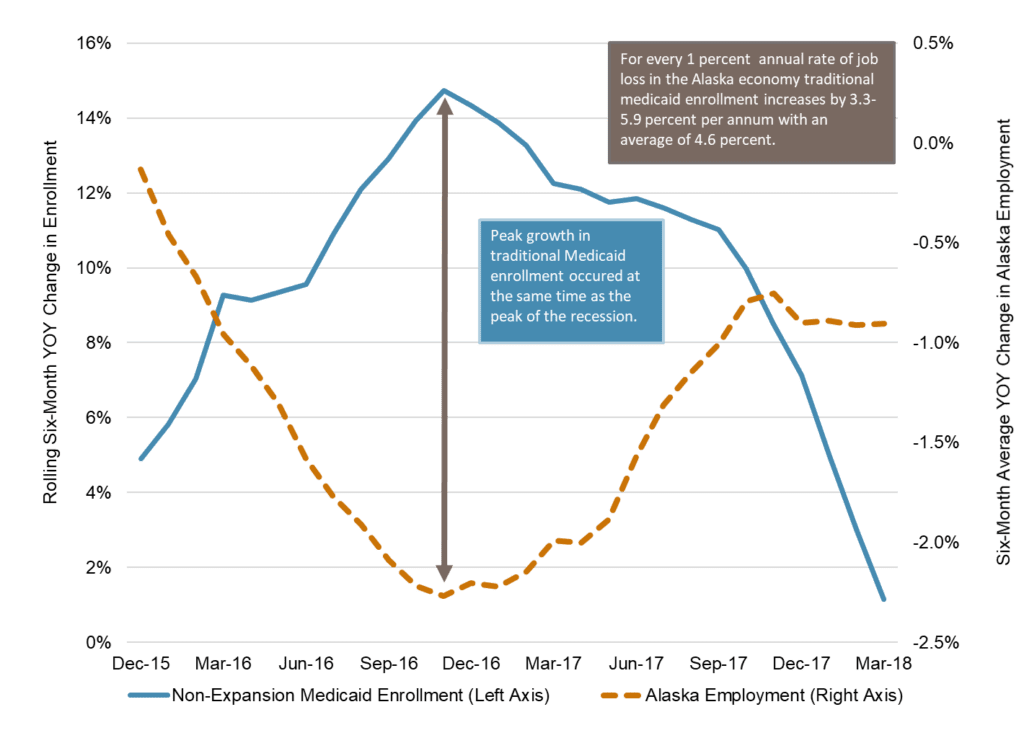 Before You Go Any Further!
Before You Go Any Further!
I need your help. Next month I’m going to be writing my mid-year economic update and I want to hear your thoughts on the condition of Alaska’s economy. Is it up? Down? Flat?? Before you read any further click this link askjonathan@apcm.net and send me a short email. Once you’ve given me your deepest insights, don’t forget to come back and read this month’s main dish.
The Relationship between Medicaid and the Economy
Do you remember watching cartoons as a child and the hero of the story would climb to the top of circus tower and dive into a tiny cup of water at the bottom and then the villain would do the same, but would tragically and catastrophically fail to fit into the cup? Metaphorically, I’m about to take that leap as I try to fit one of Alaska’s most complicated issues into a succinct blog post. Here’s what you need to know for background:
- The Alaska Department of Health and Social Services (AKHSS) is Alaska’s largest budget line item accounting for $3.2 billion out of $10.3 billion budget (including the Permanent Fund Dividend). That’s 30% of our overall budget FY ’19 budget.
- With respect to the unrestricted general fund (UGF) budget (i.e., the one we fight over every year), AKHSS is $1.1 billion out of the $5.5 billion FY ’19 UGF budget including the PFD. So, 20 cents of every dollar that we’re spending of our own money goes to AKHSS.
- The Medicaid program is the largest portion of the AKHSS UGF budget at $661 million out of the $1.1 billion. Thus, about 12.5 cents out of every dollar of our own money that we’re spending in Alaska goes to funding our share of the Medicaid program.
- Over 200,000 Alaskans, 1 in every 3.65, is now enrolled in Medicaid. Simply put, every fourth person that you meet walking down the street is part of Medicaid, either as part of the traditional program or as part of the expansion population created by “Obamacare”.
For the rest of this post we’re going to set the “Obamacare” folks aside. These individuals are childless, uninsured poor adults who likely don’t make enough to purchase insurance on the subsidized exchanges. Yes, they’re now 20% of the program’s population, but the Federal Government pays for more than 90% of their costs. So, they count towards that $3.2 billion of combined state and federal money that we’re spending, but not as much towards the $661 million which comes from our own pocket. Let’s just focus on the traditional Medicaid population composed of three groups: (i) low income families, children, and pregnant women; (ii) low-income elders; and (iii) low-income disabled persons.
Prior to the third quarter of 2015 traditional Medicaid population was growing at the rate of population rate growth at about 0.8% per year (see Figure 1) ; cost pressures primarily came from Alaska’s ever-increasing cost of medical care and the cost of transportation. Between late 2015 and mid 2017 the compounded annual growth rate hit the hyperdrive exploding from 0.8% per year to 9% per year with a peak rate close to 14% per year. An additional 35,000 bodies at $11,000 a year is a whole lot of cost pressure on the system. Yet, state expenditures stayed comparatively flat thanks to some smart and aggressive management at AKHSS and a helpful Obama Administration. Traditional Medicaid enrollment peaked last summer at 163,000 enrollees, up from ~125,000 in 2014, and the six-month average is now running at 159,525.
Figure 1. Traditional Medicaid Population in Alaska July 2014-March 2018
Source: Halcyon Consulting 2018 from Alaska Department of Health and Social Services, 2018.
Why the surge in enrollment in late 2015? One argument, for which I have yet to find supporting or opposing data, is that the Walker Administration’s decision to open Medicaid expansion helped to increase the traditional population. In short, aggressive expansion efforts pulled Alaskans who were eligible, but not using traditional Medicaid, into the traditional program. The second argument, which is strongly supported by Alaska Department of Labor and Workforce Development data, is that falling employment pushed people into eligibility. Let me say that again for clarity: For the first argument there is no quantitative data either way and I do not take a position. On the second argument, let’s look at the data, which is pretty darn amazing (That’s a technical term there).
Prior blog readers know that I like to use a six-month rolling average of year-over-year change to smooth out irregularities in monthly data. Figure 2 below shows that metric for both the employment in Alaska (i.e., the dashed line/the right vertical axis) and traditional Medicaid enrollment (i.e., the solid line/left vertical axis). Basically, we’re looking at the growth rate for these two metrics. What do we see in those two lines?
- They’re the near mirror image of each other.
- The growth rate in traditional Medicaid population peaked at over 14 percent per year at the same time as the recession peaked in late 2016.
- Now that losses in the economy are moderating (more on that next month), the growth rate in Medicaid enrollment has slowed to less than one percent.
Rarely in socio-economics do we see as strong a relationship between two factors as we see in Figure 2. . A regression analysis estimates that for every 1 percent annual rate of loss in Alaska’s employment we should expect Medicaid enrollment to grow at a rate of 3.3 and 5.9 percent. For those who don’t love statistics, “It’s the economy!”.
Figure 2. Relationship between Change in Employment and Change in Medicaid Enrollment
Source: Halcyon Consulting 2018 from Alaska Department of Health and Social Services, 2018.
If you’re still reading this blog post let me say “thank you!”. It shouldn’t come as surprise to anyone that worsening economic conditions would push people to seek aid from social insurance program. The effect of recessions on Medicaid demand is well documented throughout the country. Interestingly, the current enrollment growth rate is much better than what we would expect given revised ADOWLD employment data which still show a state in recession. Have we just run out of people to enroll? Is AKHSS paperwork backlog affecting their data? Or, are economic conditions better than what the employment data show?
Jonathan’s Takeaway: Jonathan’s not sure if he fit it into the cup or if he went splat, but Alaska’s Medicaid is intensely complex and expensive. Regardless of whether you’d like a smaller Medicaid program or a more expansive program it behooves us to understand the program’s cost drivers. This write-up is the equivalent of one piece in a thousand-piece puzzle.
Jonathan King is a consulting economist and Certified Professional Coach. His firm, Halcyon Consulting, is dedicated to helping clients reach their goals through accountability, integrity, and personal growth. Jonathan has 21 years of social science consulting experience including 15 years in Alaska. The comments in this blog do not necessarily represent the view of employers and clients past or present and are Jonathan’s alone. Suggested blog topics, constructive feedback, and comments are desired at askjonathan@apcm.net.
5/16/18










